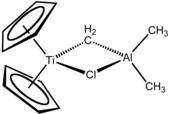Central Research
| CRD Research Directors and
Vice Presidents |
Years |
|---|---|
| Paul L.Salzberg | 1957–1967 |
| David M. McQueen | 1968–1971 |
| Theodore L. Cairns | 1972–1975 |
| Howard Ensign Simmons, Jr. | 1975–1979 |
| C. Edward Lorenz | 1980 |
| Robert Naylor | 1981 |
| Charles Bottomley | 1982–1983 |
| Richard Quisenberry | 1984–1992 |
| Joseph Miller | 1993–1995 |
| James M. Meyer | 1997–2000 |
| Thomas M. Connelly | 2001–2005 |
| Uma Chowdhry | 2006–2010 |
| Douglas W. Muzyka | 2010–2016 |
| Cramer’s Dimer |
|---|
 |
| Tebbe Reagent |
 |
In 1957, the research organization of the Chemicals Department of E. I. du Pont de Nemours and Company was renamed Central Research Department, beginning the history of the premier scientific organization within DuPont and one of the foremost industrial laboratories devoted to basic science. Located primarily at the DuPont Experimental Station and Chestnut Run, in Wilmington, Delaware, it has expanded to include laboratories in Geneva, Switzerland, Seoul, South Korea, Shanghai, China, and Hyderabad, India. In January, 2016 a major layoff marked the end of the organization.
The company established a tradition of basic scientific research starting with hiring of Wallace Carothers in 1928 and his systemization of polymer science that led to the development of polyamides such as nylon-6,6 and polychloroprene (neoprene) in the early 1930s. This tradition waned during World War II then underwent a renaissance in the 1950s. The establishment of Central Research in 1957 formalized a corporate commitment to basic research. The execution and publication of high quality research assisted recruiting and promoted the image of DuPont while raising morale among the CRD staff. The purpose of the research was to discover "the next nylon", because Carothers' success and the resulting commercialization of nylon had driven the Company's profits through the 1950s. (This research objective that was never met.) Nonetheless, another important stated goal for CRD was “diversification through research,” and CRD produced a stream of scientific innovations that contributed to many different businesses throughout the corporation.
Vice Presidents
CRD combined industrial and fundamental research, and the mix of the two features was often determined by the head of CR&D. The title expanded from Director of Research to Vice President of Technology to Chief Technology Officer with varying degrees of impact on research throughout the corporation as well as in CRD. The name of CRD also changed to reflect the times, starting with Chemicals Department and moving through Central Research Department (CRD), Central Research and Development Department (CR&DD), to the present Central Research and Development (CR&D).
...
Wikipedia
